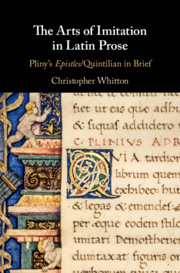Book contents
- The Arts of Imitation in Latin Prose
- The Arts of Imitation in Latin Prose
- Copyright page
- Dedication
- Epigraph
- Frontispiece
- Contents
- Ad lectorem
- Quintilian in Brief, in Brief
- Abbreviations
- Chapter 1 Two Scenes from the Life of an Artist
- Chapter 2 Setting the Stage
- Chapter 3 Brief Encounters
- Chapter 4 Dancing with Dialectic
- Chapter 5 Through the Looking-Glass
- Chapter 6 On Length, in Brief (Ep. 1.20)
- Chapter 7 Letters to Lupercus
- Chapter 8 Studiorum secessus (Ep. 7.9)
- Chapter 9 Docendo discitur
- Chapter 10 Reflections of an Author
- Chapter 11 Quintilian, Pliny, Tacitus
- Chapter 12 Beginnings
- References
- Index locorum
- Index of Greek and Latin Words
- General Index
Chapter 1 - Two Scenes from the Life of an Artist
Published online by Cambridge University Press: 10 June 2019
- The Arts of Imitation in Latin Prose
- The Arts of Imitation in Latin Prose
- Copyright page
- Dedication
- Epigraph
- Frontispiece
- Contents
- Ad lectorem
- Quintilian in Brief, in Brief
- Abbreviations
- Chapter 1 Two Scenes from the Life of an Artist
- Chapter 2 Setting the Stage
- Chapter 3 Brief Encounters
- Chapter 4 Dancing with Dialectic
- Chapter 5 Through the Looking-Glass
- Chapter 6 On Length, in Brief (Ep. 1.20)
- Chapter 7 Letters to Lupercus
- Chapter 8 Studiorum secessus (Ep. 7.9)
- Chapter 9 Docendo discitur
- Chapter 10 Reflections of an Author
- Chapter 11 Quintilian, Pliny, Tacitus
- Chapter 12 Beginnings
- References
- Index locorum
- Index of Greek and Latin Words
- General Index
Summary
Chapter 1 serves as a prelude, exemplifying argument and method with two brief tableaux. Epistles 1.6 is Pliny’s first letter to Tacitus, and his first self-portrait as leisured man of study, writing in the woods of his Umbrian estate. Epistles 9.36 is a late, intimate account of Pliny’s daily routine at the same villa. Each letter engages closely with Institutio 10.3, Quintilian’s chapter on how to write. Quintilian rejects dictation, recommends solitude and dismisses claims that the countryside is the best place for composition. With a ‘divided imitation’, Pliny offers an intricate and subtle reply on all three points, so inscribing the Institutio into two cardinal letters which cut to the heart of the Epistles as autobiography and as minutely crafted text.
- Type
- Chapter
- Information
- The Arts of Imitation in Latin ProsePliny's <I>Epistles</I>/Quintilian in Brief, pp. 1 - 19Publisher: Cambridge University PressPrint publication year: 2019

